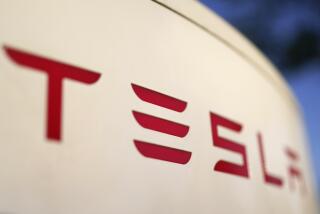Arizona halts Uber self-driving tests; supplier says Uber disabled Volvo safety system before fatality
Arizona Gov. Doug Ducey suspended Uber Technologies Inc.’s self-driving car tests on Monday, after the death of a pedestrian who was hit by one of the company’s vehicles while crossing a road in Tempe.
“Improving public safety has always been the emphasis of Arizona’s approach to autonomous vehicle testing, and my expectation is that public safety is also the top priority for all who operate this technology in the state of Arizona,” Ducey said in his letter to Chief Executive Dara Khosrowshahi.
“The incident that took place on March 18 is an unquestionable failure to comply with this expectation.”
Also on Monday, the auto-parts maker that supplied the radar and camera on the Volvo SUV that struck and killed the woman last week said Uber had disabled the standard collision-avoidance technology in the vehicle.
“We don’t want people to be confused or think it was a failure of the technology that we supply for Volvo, because that’s not the case,” Zach Peterson, a spokesman for Aptiv, said by phone. The Volvo XC90’s standard advanced driver-assistance system “has nothing to do” with the Uber test vehicle’s autonomous driving system, he said.
Aptiv is speaking up for its technology to avoid being tainted by the fatality involving Uber, which may have been following standard practice by disabling other tech as it develops and tests its own autonomous driving system. Experts who saw video of the Uber crash pointed to apparent failures in Uber’s sensor system, which failed to stop or slow the car as 49-year-old Elaine Herzberg crossed a street pushing a bicycle.
Police in Tempe, Ariz., and the National Transportation Safety Board are investigating the incident.
Uber didn’t immediately respond to a request for comment.
The driverless technology industry has tried in recent days to separate itself from the Uber fatality. Intel Corp.’s Mobileye, which makes chips and sensors used in collision-avoidance systems and is a supplier to Aptiv — which helps power the Volvo XC90’s driver-assistance system — said Monday that it tested its own software after the crash by playing a video of the Uber incident on a television monitor.
Mobileye said it was able to detect Herzberg one second before impact in its internal tests, despite the poor secondhand quality of the video relative to a direct connection to cameras equipped to the car.
Waymo CEO John Krafcik on Saturday said his company’s self-driving software would probably have avoided the pedestrian death. “We have a lot of confidence that our technology would be robust and would be able to handle situations like that one,” Krafcik said in a speech to car dealers. Alphabet Inc.’s Waymo, the former Google car project, is considered the technical leader in the field.
Meanwhile, a top executive for the maker of sensors used on the self-driving Uber vehicle said she was “baffled” as to why the tech-outfitted vehicle failed to recognize a pedestrian crossing the street and hit the brakes.
Marta Thoma Hall, president of Velodyne Lidar Inc., maker of the special laser radar that helps an autonomous car “see” its surroundings, said the company doesn’t believe its technology failed. But she’s surprised the car didn’t detect Herzberg.
“Certainly, our Lidar is capable of clearly imaging Elaine and her bicycle in this situation,” Thoma Hall wrote in an email. “However, our Lidar doesn’t make the decision to put on the brakes or get out of her way.
“In addition to Lidar, autonomous systems typically have several sensors, including camera and radar to make decisions,” she wrote. “We don’t know what sensors were on the Uber car that evening, if they were working, or how they were being used.”
Uber’s fatal crash immediately sparked a series of questions for the nascent driverless car industry. Some states, particularly Arizona, have embraced the tech, permitting companies to test without backup drivers behind the wheel.
Still, regulators nationwide have yet to settle on issues of liability and standard safeguards. California demands companies disclose how many times humans must take over the systems — a rare test requirement that sent some firms to other states with less-stringent regulation.
The New York Daily News contributed to this report.
UPDATES:
7:10 p.m.: This article was updated to indicate that Arizona had suspended Uber testing.
This article was first published at 4:10 p.m.






